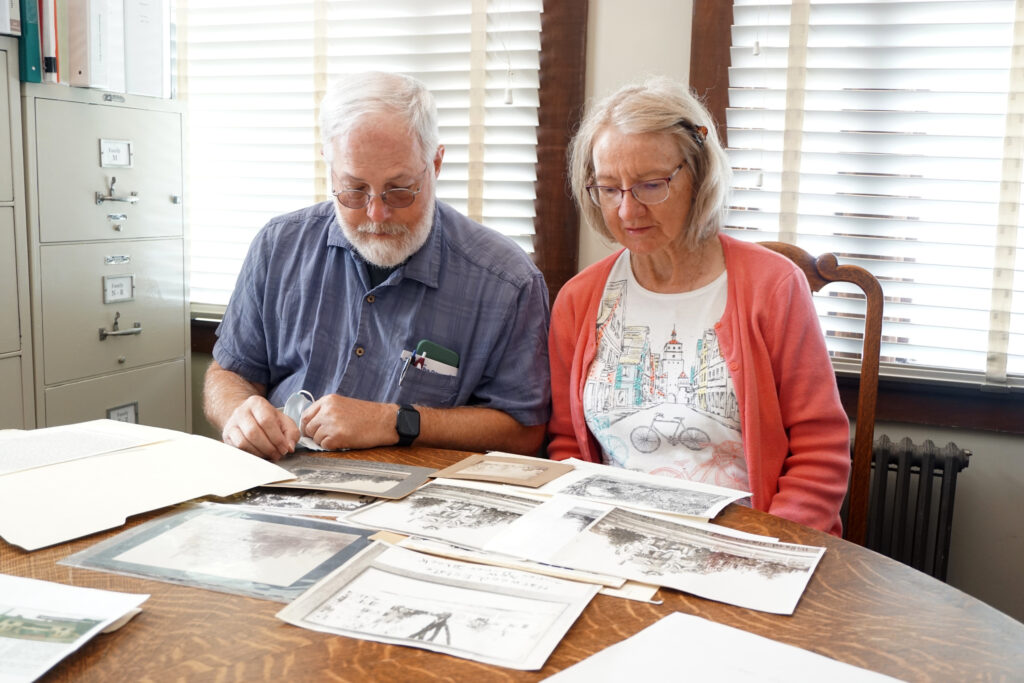Oct 1, 2022
Ed. note: Paul and Rebecca Harwood, who live in Oregon, visited the Medfield Historical Society August 27 and spent a couple of hours doing research.

Most residents of Medfield are likely aware of Baxter Park: a patch of green at the intersection of Routes 109 and 27, directly opposite the CVS Pharmacy. It’s home to a series of memorials commemorating Medfield residents who’ve served their country in the armed forces, dating back to the Revolution.
Fewer people may be aware that the land for the park was donated to the town of Medfield by Willard Harwood, my great-great-grandfather; fewer still will know who he was, or his connection to the Baxter family, or possibly even the Baxter family’s place in Medfield’s history.
The first Baxter in Medfield was the Reverend Joseph Baxter (1676-1745). He graduated from Harvard College in 1693, at age 17, and was such an impressive preacher that he was called to be Medfield’s second minister in 1695. He remained in Medfield for the rest of his life, serving as minister for over 50 years.
Joseph Baxter had a son named John Baxter, who in turn had a son named John Baxter. This second John Baxter served as a lieutenant in the Continental Army during the Revolutionary War, and his name is on the Baxter Park Memorial for that war. He served Medfield for years as town treasurer and as a magistrate, and as a state representative.
The three generations of Baxter men managed to amass a sizeable estate. John Baxter the magistrate had one daughter, Sarah Baxter, who married a man named Nathaniel Bosworth. Bosworth was an interesting character, sort of an itinerant inventor who traveled off to Savannah, Georgia, with Lowell Mason, Medfield’s famous musician, and George Whitefield Adams, apparently to build and modify church organs. Bosworth must have returned to Medfield from time to time, because he and Sarah had four children. He died suddenly in New York and is buried there.
Of the Bosworth children, only a daughter named Mary Baxter Bosworth married. She married Charles Hamant in 1841, and then she died in 1844 at age 31. Charles and Mary had one daughter, named Mary Baxter Hamant. Mary Baxter Hamant, the last of the direct Baxter line, married Willard Harwood in 1863 when she was 19 and he was 27.
Willard had five living brothers, most of whom were in and out of the jewelry and watchmaking trades, though one of them was a shoemaker. Their father, Reuben Harwood, died in 1838 at age 40. Two of Willard’s brothers, Charles and Lucian, had formed a jewelry firm called L & C Harwood.
Lucian left the jewelry business and became a druggist, so Willard teamed up with Charles in 1859, and they formed Harwood Brothers Jewelry. According to his obituary in 1902, Charles suffered from ill health and traveled in Europe to further the jewelry business while Willard kept shop in Boston. Harwood Brothers Jewelry became a prosperous firm; silverware that they manufactured can still be found on eBay today. It is stamped “Harwood Brothers”.
Willard and Mary made their home in Boston, though they kept up the Baxter homestead in Medfield. This was the same homestead purchased by Joseph Baxter in 1696, and which had been the principal home of the Medfield Baxters for the two centuries since.

When Mary died in 1891, Willard decided to raze the Baxter home; in its place, he erected a brick mansion, shown in the accompanying photo. He made Medfield his principal residence once the mansion was complete, and he became involved in civic affairs as something of a philanthropist.
When Willard drew up his will, he added a provision that a one-acre plot of land directly across the street from his mansion would be donated to the town of Medfield, stipulating that the town of Medfield should “forever keep and maintain (it) for a public park and for no other use whatever; that it shall forever be called and known as ‘Baxter Square’…”
Willard died in 1916 and is buried with his wife, Mary, along with her Baxter forebears, at Vine Lake Cemetery in Medfield. At that point the land passed over to Medfield.
Willard’s mansion in Medfield passed to his daughter Edith; she and her husband had been living in Medfield with Willard. They eventually moved to Boston, the mansion was sold, and in the 1950s torn down and replaced by Medfield’s first supermarket, the Super Duper. The site of the Baxter homestead and Willard’s mansion is now occupied by the CVS across the street from Baxter Park.
It’s curious to me that Willard tore down his wife’s ancestral home to erect a mansion the same year that she died, but his devotion to her lives on in Baxter Park.
Willard Harwood’s son, Harry Adams Harwood (my great-grandfather) was an enthusiastic genealogist and had photos of Willard and Mary. I have posted them online at wikitree here (Willard) and here (Mary).
There are photos of other members of the Harwood and Baxter families that you can see by following the links on the WikiTree pages.